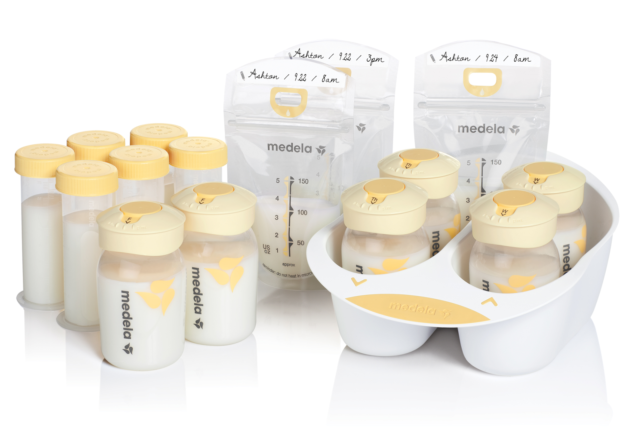Mothers find it convenient or even necessary to collect their breastmilk and store it to be used at a later time. Such is the case for mothers who are returning to work or school or for mothers who may need to be separated from their infants.So Breast milk storage is important but can be confusing. From following these tips on choosing containers, freezing breast milk, thawing breast milk and more they can safely store their breastmilk.
Safely collecting breast milk
- Make sure that your hands are properly Washed with soap & water before expressing or handling breast milk.
- Wash all the collecting bottles and breast pump parts that touch your breasts or the milk. Use hot, soapy water or a dishwasher. Rinse carefully. Air dry on a clean towel.If your baby is premature or ill, the hospital may ask you to sterilize your pump parts.
- Read the instruction book that comes with your pump and follow the suggestions.Sterilize your pump parts once a day as described.
- Practice pumping when you are rested, relaxed and your breasts feel full. Once a day try to breastfeed your baby only on one side and pump the other breast. Or pump for a few minutes if your baby skips a feeding or breastfeeds for only a short while. Read the Breastmilk Storage chart to learn how to store breastmilk. Be sure to use the right size breast shield so that your nipple fits comfortably.
- When collecting milk, be sure to store it in clean containers, such as screw cap bottles, hard plastic cups with tight caps, or heavy-duty bags that fit directly into nursery bottles. Avoid using ordinary plastic storage bags or formula bottle bags, as these could easily leak or spill.
- Employed moms can help their baby learn to take a bottle once breastfeeding is going well. It is best to wait for three (3) to four (4) weeks to introduce bottles. If you are having problems breastfeeding, ask for help from a lactation consultant or health care provider.
- Begin to pump to store milk one (1) to two (2) weeks before returning to work. Many employed moms use the fresh milk they pump at work for feedings the next day. They refrigerate Friday’s milk for use on Monday. Save your frozen milk for emergencies.
- Pump three (3) times during an eight (8) hour work shift, or every three (3) hours you are away from your baby. Ten minutes of pumping during breaks and 15 minutes of pumping during lunch with a good pump will help protect your milk supply. If you can’t pump three (3) times, pump as much as you can during each day.
- Breastfeeding in the evening and on days off helps maintain your milk supply and protects your special bond with your baby.
PLEASE NOTE
- If delivering breast milk to a child care provider, clearly label the container with the child’s name and date.
- Clearly label the milk with the date it was expressed to facilitate using the oldest milk first.
- Do not add fresh milk to already frozen milk within a storage container. It is best not to mix the two.
- Do not save milk from a used bottle for use at another feeding.
- Clean breast pump parts after each use. Visit the U.S. Food and Drug Administration (FDA) web site on Cleaning a Breast Pump for additional information.
Safely storing Breastmilk
- It is normal for pumped milk to vary in color, consistency and scent depending on your diet. Stored milk separates into layers. Cream will rise to the top. Gently swirl the warmed bottle to mix the milk layers.
- You can continue to add small amounts of cooled breastmilk to the same refrigerated container throughout the day. Avoid adding warm milk to already cooled milk.
- Pumped milk may be added to frozen milk provided it is first chilled and the quantity is less than what is frozen.
- Store your milk in breastmilk collection bottles or in disposable bags specifically designed for breastmilk.
- Freeze milk in two (2) to five (5) oz portions. Small amounts will thaw more quickly. You will waste less milk this way and will avoid over-feeding. Aqueous liquids expand when frozen. Be sure to leave some extra room at the top of the container so the bottle or bag won’t burst.
- Seal containers tightly. Write the date on a piece of tape on the bag or bottle. Use the oldest milk first.
Storage Duration of Fresh Human Milk
Source: American Academy of Pediatrics
Breastmilk Storage Guideline References
- Hamosh M, Ellis L, Pollock D, Henderson T, and Hamosh P: Pediatrics, Vol. 97, No. 4, April 1996. pp 492-497. (4 hours at 77° F/25° C).
- The Academy of Breastfeeding Medicine Protocol Committee. ABM Protocol #8: Human milk storage information for home use for healthy full-term infants. 2004.
- Adeola, K.F., Otufowora, O.A. Effect of Storage Temperature of microbial quality of infant milk. J Tropical Peds 1998 Feb; 44(1): 54-55.
- Hands, A. Safe Storage of expressed breast milk in the home. MIDIRS Midwifery Digest 2003: 13(3):378-85.
- Jones, F. and Tully, M.R. Best Practice for Expressing, Storing and Handling Human Milk in Hospitals, Homes and Child Care Settings, Second Edition. The Human Milk Banking Association of North America, 2006.
- Lawrence, R. and Lawrence, R. Breastfeeding: A Guide for the Medical Profession, Sixth Edition. St. Louis; Mosby, 2005; 1018-20.
- Martinez-Costa, C., Silvestre, M.D., and Lopez, M.C. et al Effects of refrigeration on the bactericidal activity of human milk: A preliminary study. J Pediatr Gastroenterol Nutr 2007; 45:275-77.
References
cdc. 2017. handling_breastmilk. [ONLINE] Available at: https://www.cdc.gov/breastfeeding/recommendations/handling_breastmilk.htm. [Accessed 23 June 2017].
medelabreastfeedingus. 2017. breastfeeding. [ONLINE] Available at: http://www.medelabreastfeedingus.com. [Accessed 23 June 2017].





